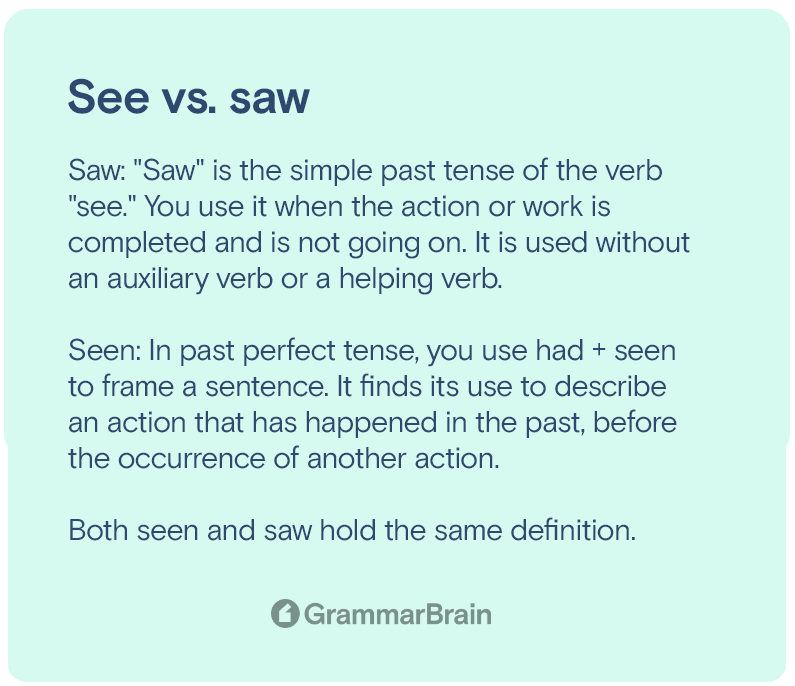

What is the difference between “seen” and “saw?” Seen and saw are respectively, the past participle and simple past tense forms of the irregular verb “see.” The word “see” is an irregular verb. To “see” means to make a note of something by using your eyes.
Synonyms– looked, noticed, observed, sighted, spied, viewed, witnessed, viewed, discovered, realized.
Antonyms– ignored, passed over, overlooked, missed, disregarded.
“Saw” is the simple past tense of the verb “see.” You use it when the action or work is completed and is not going on. It is used without an auxiliary verb or a helping verb. See the examples to see how to use it in the simple past tense form.
Since seen is the past participle form of the verb see – it needs auxiliary verbs like has, have, or had to form sentences, while saw is a standalone verb. It is the main difference to remember when using seen and seen.
Seen is used in both present perfect tense and past perfect tense. Do not get overwhelmed by the terms used if you do not know them. The examples will show that it is pretty simple.
| Word | Definition |
| Seen (verb) | past participle of see. |
| Saw (past tense) | perceive with the eyes; discern visually. |
You will observe that you get the past tense or past participle forms of many verbs by adding d or ed to the root word. These are regular verbs.
For example, the past tense of smile is smiled, like is liked, and create is created. We have added ‘d’ to the root word to get the past tense form. The past tense of play is played, clean is cleaned, and brush is brushed, where we have added ed to the root word to get the past tense.
Any verb that does not follow this pattern is called an irregular verb. We do not add d or ed to the verb see to get the past or participle form. Other irregular verbs are drink, sing, eat, etc.

In the present perfect form, you use the helping verbs, has or have + seen, to frame sentences.
Remember, in this tense form, you do not use a specific time when the event happened.
Or you use it if the action continues to happen till the present.
In past perfect tense, you use had + seen to frame a sentence. It finds its use to describe an action that has happened in the past, before the occurrence of another action.
You had seen me dancing on the terrace before the program began. (Here, both actions happened and got completed in the past.)
Saw and seen are the different forms of the verb see.
Saw is used in simple past tense and does not need helping verbs.
Seen is used in the past and present perfect tense and always needs a helping verb in a sentence.
The correct phrase would be, “I saw.” For example, “I saw a monkey at the zoo and he was very curious about me.”
Is it “I have seen” or “I have saw?”The correct phrase would be, “I have seen.” For example, “I have seen 15 cities across the United States.”
Inside this article

Fact checked:
Content is rigorously reviewed by a team of qualified and experienced fact checkers. Fact checkers review articles for factual accuracy, relevance, and timeliness. Learn more.

About the author
Dalia Y.: Dalia is an English Major and linguistics expert with an additional degree in Psychology. Dalia has featured articles on Forbes, Inc, Fast Company, Grammarly, and many more. She covers English, ESL, and all things grammar on GrammarBrain.